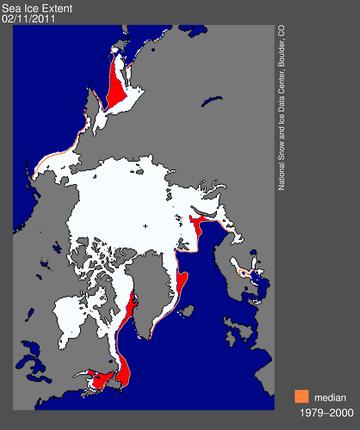The Arctic Ice is preparing itself for a large reduction in sea ice area this summer. The summer of 2007 surprised climatologists when a summer low in ice area was set at about 3 million sqkm. To put that in perspective, in the early 1980’s, the Arctic sea ice would melt back to an area around 5 mil sqkm.
The current ice coverage is 1.1 mil sq km less than what it should be, and should be setting a record low for winter ice area this winter.
I’ve marked the “missing ice” in red above. A lot of it is in Quebec and Newfoundland. I’m guessing that the residents there don’t consider themselves to be part of the Arctic.
Some of the “missing ice” is in the Greenland Sea, which is an indication that ice has been retained in the Arctic Basin this winter. Greenland Sea ice gets there by flowing out of the Arctic, and is all doomed to melt in the near future.
Most of the rest of the “missing ice” is in the Sea of Okhotsk, where the ice always melts by early summer.
The point is that winter ice extent tells you nothing about the condition of the ice in the Arctic Basin. Theorizing about the summer minimum based on February extent is just plain daft. As I pointed out earlier, 2006 was the lowest in February and the highest in September in the DMI record.
My forecast is that NSIDC ice age maps will again show an increase in the area of thick multi-year ice this spring.



You got that right about Quebec and Newfoundland don’t consider themselves to be part of the Arctic.
Think of the seals that can’t have pups this spring off Nfld…
What will Greenpeace do with nothing to do there this spring?
Maybe they can stage a seal clubbing and skin them alive like they done before and blame on the seal hunt.
Regards the missing ice in the Sea of Okhotsk, tell that to the Russians who had ships stuck in it for weeks. Almost lost the lot including a couple of ice-breakers.
EUReferendum has been following the story closely. (sorry, no link, too lazy)
That was the first thing I thought too.
The frig ship was stuck from Dec until last week.
They just finally got it out.
If it wasn’t for the desperate alarmist hoopla, 99.99% of the population would never notice the difference.
Big underestimate…I’d guess that only ~50000 people in the world live in those areas where there is visible missing ice, maybe fewer. Anyone have a better estimate? The above number is pretty random.
Anyway, that’s a lot closer to 99.999% of the world’s population not being able to tell the difference. 🙂
-Scott
The Sea of Okhotsk remains as much as a mystery as two years ago…